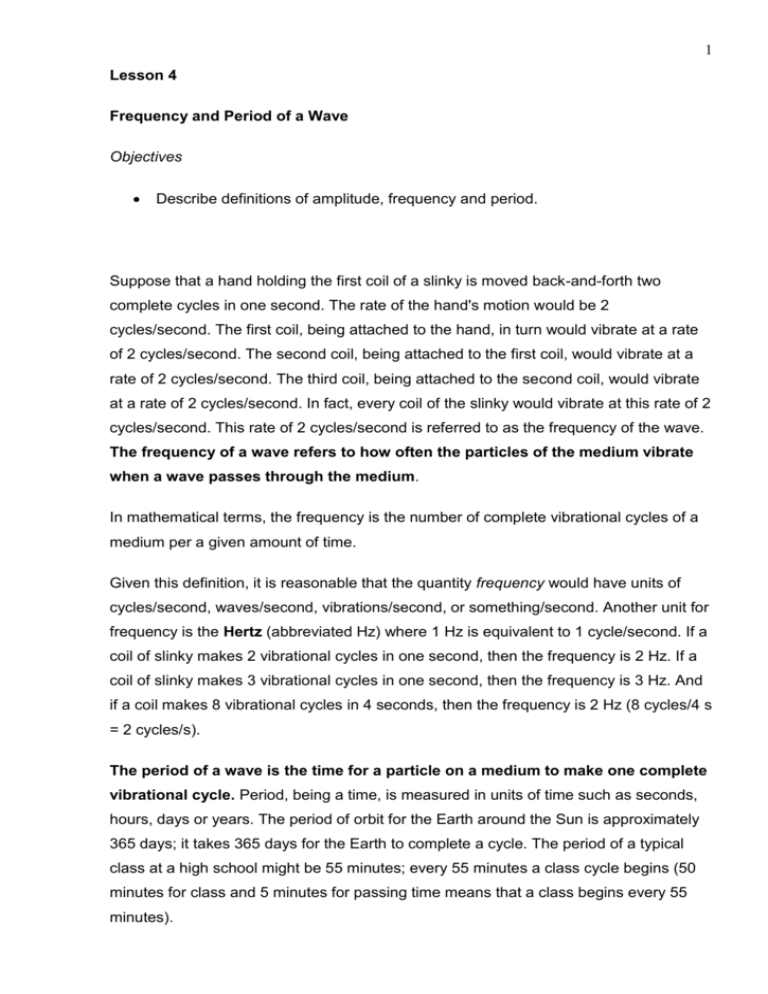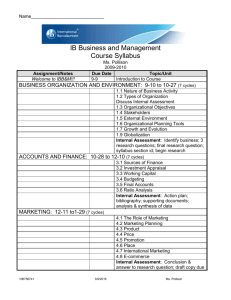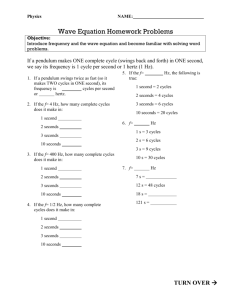The Anatomy of a Wave
advertisement

1 Lesson 4 Frequency and Period of a Wave Objectives Describe definitions of amplitude, frequency and period. Suppose that a hand holding the first coil of a slinky is moved back-and-forth two complete cycles in one second. The rate of the hand's motion would be 2 cycles/second. The first coil, being attached to the hand, in turn would vibrate at a rate of 2 cycles/second. The second coil, being attached to the first coil, would vibrate at a rate of 2 cycles/second. The third coil, being attached to the second coil, would vibrate at a rate of 2 cycles/second. In fact, every coil of the slinky would vibrate at this rate of 2 cycles/second. This rate of 2 cycles/second is referred to as the frequency of the wave. The frequency of a wave refers to how often the particles of the medium vibrate when a wave passes through the medium. In mathematical terms, the frequency is the number of complete vibrational cycles of a medium per a given amount of time. Given this definition, it is reasonable that the quantity frequency would have units of cycles/second, waves/second, vibrations/second, or something/second. Another unit for frequency is the Hertz (abbreviated Hz) where 1 Hz is equivalent to 1 cycle/second. If a coil of slinky makes 2 vibrational cycles in one second, then the frequency is 2 Hz. If a coil of slinky makes 3 vibrational cycles in one second, then the frequency is 3 Hz. And if a coil makes 8 vibrational cycles in 4 seconds, then the frequency is 2 Hz (8 cycles/4 s = 2 cycles/s). The period of a wave is the time for a particle on a medium to make one complete vibrational cycle. Period, being a time, is measured in units of time such as seconds, hours, days or years. The period of orbit for the Earth around the Sun is approximately 365 days; it takes 365 days for the Earth to complete a cycle. The period of a typical class at a high school might be 55 minutes; every 55 minutes a class cycle begins (50 minutes for class and 5 minutes for passing time means that a class begins every 55 minutes). 2 Frequency and period are distinctly different, yet related, quantities. Frequency refers to how often something happens. Period refers to the time it takes something to happen. Frequency is a rate quantity. Period is a time quantity. Frequency is the cycles/second. Period is the seconds/cycle. Mathematically, the period is the reciprocal of the frequency and vice versa. In equation form, this is expressed as follows. Since the symbol f is used for frequency and the symbol T is used for period, these equations are also expressed as: The quantity frequency is also confused with the quantity speed. The speed of an object refers to how fast an object is moving and is usually expressed as the distance traveled per time of travel. For a wave, the speed is the distance traveled by a given point on the wave (such as a crest) in a given period of time. So while wave frequency refers to the number of cycles occurring per second, wave speed refers to the meters traveled per second. A wave can vibrate back and forth very frequently, yet have a small speed; and a wave can vibrate back and forth with a low frequency, yet have a high speed. Frequency and speed are distinctly different quantities. 3 Learning activity . Check Your Understanding Throughout this unit, internalize the meaning of terms such as period, frequency, and wavelength. Utilize the meaning of these terms to answer conceptual questions; avoid a formula fixation. 1. A wave is introduced into a thin wire held tight at each end. It has an amplitude of 3.8 cm, a frequency of 51.2 Hz and a distance from a crest to the neighboring trough of 12.8 cm. Determine the period of such a wave. 2. Frieda the fly flaps its wings back and forth 121 times each second. The period of the wing flapping is ____ sec. 3. A tennis coach paces back and forth along the sideline 10 times in 2 minutes. The frequency of her pacing is ________ Hz. a. 5.0 b. 0.20 c. 0.12 d. 0.083 4. Non-digital clocks (which are becoming more rare) have a second hand which rotates around in a regular and repeating fashion. The frequency of rotation of a second hand on a clock is _______ Hz. a. 1/60 b. 1/12 d. 1 e. 60 c. 1/2 4 5. Olive Udadi accompanies her father to the park for an afternoon of fun. While there, she hops on the swing and begins a motion characterized by a complete back-and-forth cycle every 2 seconds. The frequency of swing is _________. a. 0.5 Hz b. 1 Hz c. 2 Hz 6. In problem #5, the period of swing is __________. a. 0.5 second b. 1 second c. 2 second 7. A period of 5.0 seconds corresponds to a frequency of ________ Hertz. a. 0.2 b. 0.5 d. 0.05 e. 0.002 c. 0.02 8. A common physics lab involves the study of the oscillations of a pendulum. If a pendulum makes 33 complete back-and-forth cycles of vibration in 11 seconds, then its period is ______. 5 9. A child in a swing makes one complete back and forth motion in 3.2 seconds. This statement provides information about the child's a. speed b. frequency c. period 10. The period of the sound wave produced by a 440 Hertz tuning fork is ___________. 11. As the frequency of a wave increases, the period of the wave ___________. a. decreases b. increases c. remains the same 6 Answers: Check Your Understanding Throughout this unit, internalize the meaning of terms such as period, frequency, and wavelength. Utilize the meaning of these terms to answer conceptual questions; avoid a formula fixation. 1. A wave is introduced into a thin wire held tight at each end. It has an amplitude of 3.8 cm, a frequency of 51.2 Hz and a distance from a crest to the neighboring trough of 12.8 cm. Determine the period of such a wave. Answer: 0.0195 sec Here is an example of a problem with a lot of extraneous information. The period is simply the reciprocal of the frequency. In this case, the period is 1/(51.2 Hz) which is 0.0195 seconds. Know your physics concepts to weed through the extra information. 2. Frieda the fly flaps its wings back and forth 121 times each second. The period of the wing flapping is ____ sec. Answer: 0.00826 seconds The quantity 121 times/second is the frequency. The period is the reciprocal of the frequency. T=1/(121 Hz) = 0.00826 s 3. A tennis coach paces back and forth along the sideline 10 times in 2 minutes. The frequency of her pacing is ________ Hz. a. 5.0 b. 0.20 c. 0.12 d. 0.083 Answer: D Frequency refers to the number of occurrences of a periodic event per time and is measured in cycles/second. In this case, there are 10 cycles per 2 minutes (also known as 10 cycles per 120 seconds). So the frequency is f =10 cycles / 120 s = 0.0833 cycles/s 7 4. Non-digital clocks (which are becoming more rare) have a second hand which rotates around in a regular and repeating fashion. The frequency of rotation of a second hand on a clock is _______ Hz. a. 1/60 b. 1/12 d. 1 e. 60 c. 1/2 Answer: A Frequency refers to the number of occurrences of a periodic event per time and is measured in cycles/second. In this case, there is 1 cycle per 60 seconds. So the frequency is f = 1 cycle / (60 s) = (1 / 60) Hz 5. Olive Udadi accompanies her father to the park for an afternoon of fun. While there, she hops on the swing and begins a motion characterized by a complete back-and-forth cycle every 2 seconds. The frequency of swing is _________. a. 0.5 Hz b. 1 Hz c. 2 Hz Answer: A Frequency refers to the number of occurrences of a periodic event per time and is measured in cycles/second. In this case, there is 1 cycle per 2 seconds. So the frequency is 1 cycles/2 s = 0.5 Hz. 6. In problem #5, the period of swing is __________. a. 0.5 second b. 1 second c. 2 second Answer: C Period refers to the time for something to happen. In this case, the period is the time for one complete swing - given as 2 seconds. 7. A period of 5.0 seconds corresponds to a frequency of ________ Hertz. 8 a. 0.2 b. 0.5 d. 0.05 e. 0.002 c. 0.02 Answer: A Frequency is the reciprocal of the period. The period is 5 seconds, so the frequency is 1/(5 s) = 0.20 Hz. 8. A common physics lab involves the study of the oscillations of a pendulum. If a pendulum makes 33 complete back-and-forth cycles of vibration in 11 seconds, then its period is ______. Answer: 0.33 second Period refers to the time for something to happen and is measured in seconds/cycle. In this case, there are 11 seconds per 33 vibrational cycles. Thus the period is (11 s) / (33 cycles) = 0.33 seconds. 9. A child in a swing makes one complete back and forth motion in 3.2 seconds. This statement provides information about the child's a. speed b. frequency c. period Answer: B and C We now know that the period is 3.2 seconds and that the frequency is 0.31 Hz. 10. The period of the sound wave produced by a 440 Hertz tuning fork is ___________. Answer: 0.00227 seconds GIVEN: f = 440 Hz Find T 9 T = 1 / f = 1 / (440 HZ) = 0.00227 s 11. As the frequency of a wave increases, the period of the wave ___________. a. decreases b. increases c. remains the same Answer: A Period is the reciprocal of the frequency. So as f increases, 1 / f decreases.






